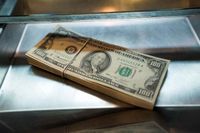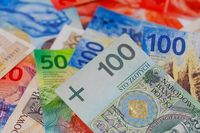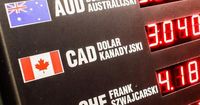On April 7, 2025, the American dollar continues its downward spiral, trading around 3.896 PLN, while the EUR/USD exchange rate holds above $1.10, reflecting a significant shift in market sentiment. Just a few months ago, in November 2024, many believed that tariffs imposed by President Donald Trump would bolster the dollar's value. However, recent developments suggest otherwise, as investors now seek stability in currencies other than the dollar, leading to a notable increase in the EUR/USD rate, which has surged over 7% since the beginning of the year, bouncing back from $1.02 to its current level of $1.10. This drastic change has left economists and analysts scrambling to understand the implications for the U.S. economy and the dollar's future.
According to economists at Goldman Sachs, the probability of a recession in the U.S. has risen to 45%, a significant increase from previous estimates. This uptick in recession risk is expected to fuel further sell-offs of the dollar and may contribute to continued rises in the EUR/USD exchange rate. The market's panic is largely attributed to fears that Trump's tariffs could lead to increased inflation and a slowdown in economic growth within the United States, prompting speculation about potential interest rate cuts by the Federal Reserve.
Despite assurances from Federal Reserve Chairman Jerome Powell that rapid interest rate cuts are not on the horizon, market logic appears to be steering in a different direction. Investors are increasingly concerned about the unpredictability of Trump's trade policies, which have eroded confidence in the dollar as a stable global reserve currency. This lack of trust has been exacerbated by the chaotic communication style of the Trump administration, where trade partners often learn about tariffs through press conferences rather than formal channels.
Bloomberg analysts have warned that the latest round of tariffs could result in a 3% drop in U.S. GDP and a 1.7% increase in prices over the next few years. If the U.S. retaliates with additional tariffs on key sectors like semiconductors and pharmaceuticals, the GDP decline could be as severe as 4.1%, with core personal consumption expenditures (PCE) rising by 2.4%. These predictions underline the growing fears surrounding the economic impact of trade wars.
Chris Turner, a leading financial markets analyst at ING, explained that the tariffs imposed by Trump are adversely affecting the American economy, leading to increased living costs for U.S. citizens. For instance, a 30% tariff on products imported from China could mean that consumers will have to pay at least one-third more for clothing, electronics, and vehicles produced in China. This situation is likely to dampen consumer spending, further contributing to a decline in GDP and a deterioration in living standards.
Moreover, U.S. companies listed on Wall Street are also feeling the strain of these new tariffs, impacting both the import of materials and their sales in foreign markets. The retaliatory tariffs mean that products from major companies like Apple, Tesla, Nvidia, and AMD will become more expensive, making them less accessible to international buyers. As a result, investors may start to divest from the dollar, seeking alternative currencies that are less affected by political pressures.
Despite the turmoil, there remains a glimmer of hope among investors that the Federal Reserve may intervene in a crisis by cutting interest rates to inject more capital into the market and ease business operations. However, such cuts would likely further weaken the dollar. Kathy Kriskey, an analyst at Invesco, remarked that the dollar's value reflects the health of the economy. She expressed concern about the current situation, stating, "We believe Trump has a plan, but we don't know what it is."
The notion of lower interest rates signals to investors that they should seek higher returns elsewhere. As rates decline, the yields on deposits, bonds, and other financial instruments denominated in dollars diminish, prompting global investors to look for better returns with lower risks in other markets. This shift could exacerbate the dollar's decline.
As of Monday morning, the dollar was trading at approximately 3.896 PLN, a slight decrease of 0.16% from the previous trading day. The euro was valued at 4.272 PLN, an increase of 0.05%. The Swiss franc was priced at 4.556 PLN, reflecting a rise of 0.64%, while the British pound was at 5.023 PLN, showing a minor drop of 0.01%. The EUR/USD rate was recorded at $1.096, up by 0.21%.
Looking back to the previous week, on April 4, the dollar was trading at 3.8560 PLN, and the euro was at 4.2403 PLN. The fluctuations in currency values are indicative of the ongoing volatility in the market, driven by geopolitical uncertainties and economic forecasts. As the situation develops, many are left wondering how much further the dollar can fall and what this means for the broader U.S. economy.
In summary, the American dollar's current trajectory reflects a complex interplay of trade policies, economic forecasts, and investor sentiment. With Goldman Sachs raising the recession probability and analysts warning of potential GDP declines, the outlook for the dollar remains precarious. As the market reacts to these developments, the EUR/USD rate's rise above $1.10 signals a shift in confidence away from the dollar, leaving many to ponder the future of the U.S. currency on the global stage.







